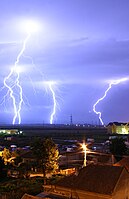
Photo from wikipedia
Atomic layer etching (ALE), a cyclic process of surface modification and removal of the modified layer, is an emerging damage-less etching technology for semiconductor fabrication with a feature size of… Click to show full abstract
Atomic layer etching (ALE), a cyclic process of surface modification and removal of the modified layer, is an emerging damage-less etching technology for semiconductor fabrication with a feature size of less than 10 nm. Among the plasma sources, inductively coupled plasma (ICP) can be a candidate for ALE, but there is a lack of research linking discharge physics to the ALE process. In this study, we comprehensively investigated the discharge physics of ICPs with a radio frequency (RF) bias and Ar/C4F6 mixture to be considered for the ALE process. Detailed studies on the discharge physics were conducted in each step of ALE (i.e., modification step, removal step) as well as the whole cycle as follows: (1) In the general ALE cycle, plasma properties dependent on the chamber geometry and the discharge mode of the ICP were analyzed; (2) in the modification step, a plasma instability with molecular gas was observed. The timescale for molecular gas removal was also investigated; (3) in the removal step, changes in plasma characteristics with the RF bias power were studied. Based on measurements of these plasma physical parameters, the discharge condition for ALE was optimized. ALE was performed on various thin films, including a-Si, poly c-Si, SiO2, and Si3N4. For each thin film, thicknesses of 0.5–2.0 nm were etched per cycle, as in quasi-ALE. Finally, ALE was performed on a patterned wafer, and the etch thickness of 0.6 nm per cycle and fine etch profile were obtained.
Journal Title: Physics of Plasmas
Year Published: 2021
Link to full text (if available)
Share on Social Media: Sign Up to like & get
recommendations!